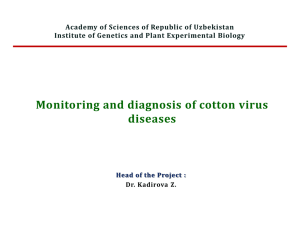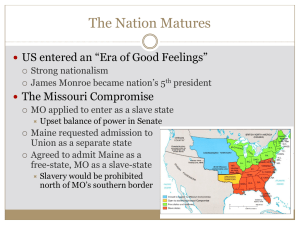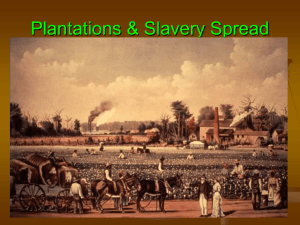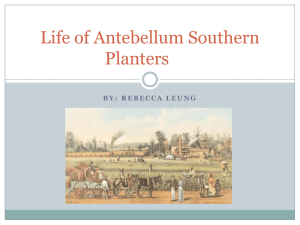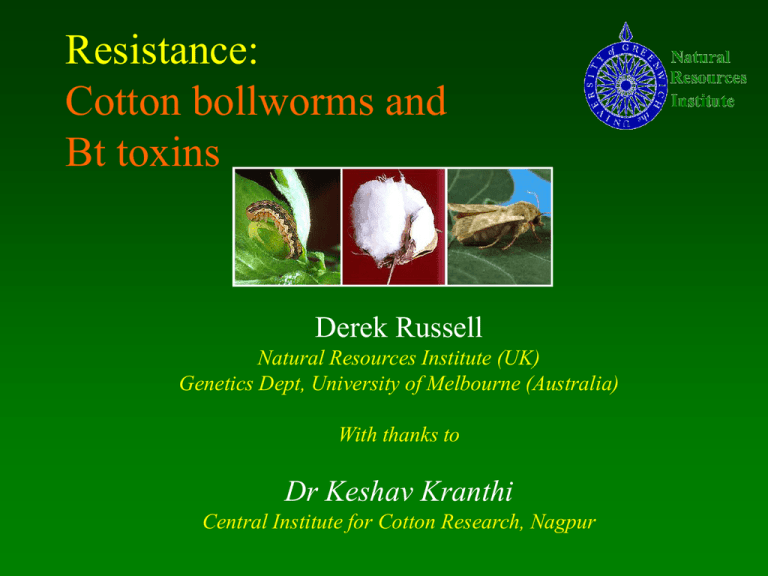
Resistance:
Cotton bollworms and
Bt toxins
Derek Russell
Natural Resources Institute (UK)
Genetics Dept, University of Melbourne (Australia)
With thanks to
Dr Keshav Kranthi
Central Institute for Cotton Research, Nagpur
Resistance
• A genetic change in a population as a result of
mortality caused by a chemical or other toxin
(e.g.Bt)
• Those organisms with more natural tolerance to
the toxin survive and breed and pass on the ability
to survive
• In time the whole population becomes able to
survive the toxin – they have become resistant!
Antibiotic Resistance
• You have multiplying bacteria in a cut.
• The doctor gives you an antibiotic
• If you don’t take the full dose – the most tolerant bacteria survive and
breed quickly
• If you do take the full dose but only once, it is possible that a few
bacteria survive to breed
• Therefore you are told to take the full 5 day course at full rates to kill
even the tolerant bacteria
Pests of cotton in India
Killed by Bt cotton
Not affected
• Bollworms
•
•
•
•
- cotton bollworm
- pink bollworm
- spiny bollworm
Leafworms (mostly)
Aphids
Jassids
Mites
Main pest groups
Bollworms
o African/American - Helicoverpa armigera
o Spiny/Spotted - Earias insulana/biplaga
o
Pink - Pectinophora gossypiella
Leafworms
o Cotton leafworms – Spodoptera sp.
Bt cotton
targets
• Cotton bollworm Helicoverpa armigera
181 host plants - 69 crop species
losses - US $ 540 mill annually
• Spiny bollworms - Earias insulana and E. vitella
• Pink bollworm - Pectinophora gossypiella
Helicoverpa armigera (American bollworm)
(CAB, 1993)
A key pest of cotton and vegetables:
Cotton bollworm –
Helicoverpa armigera
Photos: CIRAD
Commercialised transgenic plants resistant to insects
Cotton: 1st commercialised in 1996
-2004: 9 countries;
9.0 mill ha
28% global cotton area
11% of global GMO area
- Insect resistance and herbicide tolerance traits
- 25% increase in area from 2003-2004
Maize: 1st commercialised in 1996
-2004 : 8 countries
19.3 mill ha
14% global maize area
23% of global GMO area
- Insect resistance and herbicide tolerance traits
- also 25% increase in area from 2003-4
Potato: first commercialised in 1996, withdrawn in 2001
Modified from Giband 2004
Genetically Modified Bt plants
Bt plants have:
Gene (DNA) for producing the
insecticidal toxin from a soil bacterium
Promotor ‘switches’ on either side
of the gene to turn it on and off
Other regulatory genes or introns
May have ‘Marker’ gene used only
in the selection process (used to be
an antibiotic - kanamycin)
Note:
•
•
•
The plant itself makes the toxin in its tissues using the bacterial gene
The step to turn the pro-toxin into the toxin in the insect gut is not necessary
The gene may be ‘turned on’ more in some tissues than others.
Bacillus thuringiensis (Bt): More than a century of history …
• 1901 : Discovered in silkworm by a Japanese
bacteriologist Shigetane ISHIWATA “Sottokin”.
• 1911 : A new isolation by Ernst BERLINER on Ephestia
kuehniella (Zeller) larvae from Thuringe (Germany)
Bacillus thuringiensis Berliner
•1938 : First commercial preparation (Sporéine) by Libec Laboratories in France, used
against meal moth Ephestia sp. in flour.
: Bt has been used for more than 65 years as biological insecticide (>90% of the
total biopesticides market).
•1981 : first cloning of a Cry gene
•1985 : First insect resistant transgenic plant
•1990 : First commercialization of a transgenic plant (in China : virus resistant tobacco).
•1995: First Bt transgenic plant commercialised in USA
•2005: more than 81 mill ha of transgenic crops all over the world.
Mode of action of Cry toxins
J-M Vassal - CIRAD
Mode of action of Cry toxins
Domain I
Domain III
Domain II
Aminopeptidases N
Cadherins
R. A. de Maagd,
2001
Resistance mechanisms for Bt
(b) Change
solubilisation
of the toxin
Resist
Resist
(c) prevent passage
through the
peritrophic
membrane
(e) Prevent
membrane
insertion and pore
formation
Resist
Insects controlled by transgenic plants: Cotton
Toxin
Cry1Ac*
(1996)
Cry1Ac
+
Cry2Ab
(2003)
Cry1Ac
+
Cry1Ab and
or CpTi
(1997)
Cry1Ac
+
Cry1Fa
(2005)
Modified from
Giband 2004
Vip3A
(2005?)
Insects controlled
Bollworms: Cotton, Pink, Spiny
Commercial name
Bollgard ®
Delta and Pineland/Monsanto
Bollworms: Cotton, Pink, Spiny
Leafworms: Spodoptera spp
Bollgard II ®
Delta and Pineland/Monsanto
Numerous Varieties
Bollworms: Cotton, Pink, Spiny
Chinese Agademy of Agric.
Sciences
Bollworms: Cotton, Pink, Spiny
Leafworms: Spodoptera spp
WideStrike ®
Dow AgroSciences
Bollworms: Cotton, Pink, Spiny
Leafworms: Spodoptera spp
Cutworms: Agrotis sp …
VipCot ®
Syngenta
World Bt cotton adoption – 2003(2004)
Countries with pest complex like India (esp.Helicoverpa armigera)
% Area Insecticide Insecticide % sprays
use in
under use in
reduced
Non-BT
BT
Bt
Country
Year
First
Bt
Cotton
mill ha
Area Bt
cotton
USA
1996
6.2
2.0
33
5
2
60%
Mexico
1996
0.08
0.028
35
4
2
50%
China
1997
4.8
1.5
51 (66)
20
7-13
50%
Australia
1997
0.4
0.146
36 (58)
11
6
45%
Argentina
1998
0.17
0.009
5
5
2
60%
S. Africa
1998
0.044
0.02
45 (85)
11
4
64%
Indonesia
2001
0.022
0.004
18
9
3
66%
Colombia
2002
0.041
0.004
10
6
2
66%
India
2002
8.5
0.28
3 (10)
14
7
50%
Bt Cotton in China
% of total cotton area
70
60
50
40
30
20
10
0
1997
1998
1999
2000
% of cotton area
2001
2002
2003
2004
GM cotton worldwide in 2005
Area: 28% of global cotton is GM (9.5mill ha) (herbicide tolerant and insecticidal)
Countries: 9 countries with 59% of world cotton area
Farmers: c 7.2 million (>85% in developing countries – mainly China)
Bt
Cotton
>50,000
ha
Genetic
system
Single
gene
Argentina
Yes
Var.
Yes
Australia
Yes
Var.
No
1Ac/2AB
Yes
China
Yes
Var.
Yes
1Ac/(1Ab)
+CpTi
No
Colombia
No
Var.
Yes
India
Yes
Hybrid
Yes
Indonesia
No
Var.
Yes
?
Mexico
Yes
Var.
Yes
Yes
S.Africa
Yes
Var.
Yes
Yes
USA
Yes
Var.
Yes
Double gene
Technology
fee
Yes
Yes
(1Ac /2Ab)
coming soon
1Ac+2Ab
(1Ac+1Fa)
No
Yes
Expected yield improvements with Bt crops
Region
Pest
pressure
Availability Adoption of
of chemicals Chemicals
Yield effect of
GM crops
Developed
countries
Low to Med
High
High
Low
Latin America
(commercial)
Med
Med
High
Low to Med
China
Med
Med
High
Low to Med
Latin America
(non-commercial)
Med
Low to Med Low
Med to High
S. and S.E.Asia
High
Low to Med Low to Med High
Africa
High
Low
Why?:
Pest losses in non-Bt:
Low
USA 12%, China 15%
India 60%, Uganda ????
Qaim and Zilberman - Science (299 p 901) 2003
High
Target – bollworms
Cry1Ac efficacy in current Bt varieties
Efficacy:
Spiny bollworms
- Very effective
(Earias sps)
Pink Bollworm
(Pectinophora gossypiella)
Cotton bollworm
(Helicoverpa armigera)
Insecticide use:
Global experience gives an average
reduction of c.60% in insecticide
applications (80% for bollworms)
- Very effective
- Good mid-season
- Poor in late season
(reduction in bio-availability of
toxin)
Questions?
If toxin expression in Bt plants is not always
sufficient to kill bollworms it will select for
resistant insects.
• Does Bt cotton give season-long control of caterpillars?
• Are all the parts of the plant equally lethal?
• Are all Bt varieties equally effective?
• What is the chance of resistance to Bt developing?
H. armigera larval mortality
on Bt-cotton plant parts
Data from an Indian variety 2003
Top leaf
Middle leaf
Bottom leaf
Square bract
Square bud
120
% Mortlaity
100
80
60
40
20
0
27
40
60
68
75
80
87
96
104
110
Days after sowing
Kranthi et al 2003
116
124
133
138
152
159
Variability in expression of Cry1Ac in plant
parts of commercial Indian hybrids
6
Bt Hybrids
ug/gm dry wt
5
4
2-BT
20-BT
134-BT
144-BT
162-BT
184-BT
138-BT
3
2
1
0
Boll rind Boll bract loculi w all
raw
cotton
petals
sepals
anthers
ov ary
Variability in expression of Cry1Ac in plant
parts of commercial Indian hybrids
Expression < 1.8ppm is not sufficient for H.armigera control
6
Bt Hybrids
ug/gm dry wt
5
4
2-BT
20-BT
134-BT
144-BT
162-BT
184-BT
138-BT
3
2
_____________________________1.8ppm__
1
0
Boll rind Boll bract loculi w all
raw
cotton
petals
sepals
anthers
ov ary
Bt-Quant
Bt-Express
IS THERE RESISTANCE TO Bt
COTTON?
Insects resistant to sprayed Bt
• 1985
: McGaughey
-1st case of resistance to Bt - in Meal moth Plodia
interpunctella (stock grain population)
•1990 : Tabashnick et al.
– Diamond back moth Plutella
xylostella on cabbage in Hawaï
– First case of Bt resistance in the
field following intensive Bt
treatments.
Since then cases of resistance have been ONLY in the lab.
Photo - CIRAD
Bt resistance
in cotton ?
We have Bt resistance in the lab by :
Heliothis virescens (Tobacco Bollworm) - USA
Pectinophora gossypiella (Pink Bollworm) - USA
Helicoverpa armigera (Cotton Bollworm) – India, China
Helicoverpa armigera : (only in the lab.)
• In India : Kalia et Gujar, 2004
Completely recessive
Sex influenced
• In Australia : Akhurst et al, 2003
Incompletely recessive
Autosomal
• In China : Xu et al, 2005
• In China : Liang et al, 2000
• In India : Kranthi et al. 2000
Incompletely dominant
Autosomal
• In Africa : Uraichuen 2002
Completely dominant,
Autosomal
In all that works : several cross resistances with the Cry1A
family toxins
In the case of Bt resistance
One resistance gene with two alleles S and R
SS
3 genotypes
RS
RR
Dominance describe the RS phenotype compare
to SS and RR phenotype
When RS = SS
Resistance is recessive
When RS = RR
Resistance is dominant
Implications of the Indian resistance
inheritance system
• Survival on Mech 184 - Bt plants (75-85 days old)
RR two copies of the resistant gene 75%
RS one “
“ “ “
“ 33%
SS no
“
“ “ “
“
5%
• Inheritance - Semi-dominance
(0.42 and 0.55 in two
populations)
Monitoring of Bt resistance
Survey for the presence of the Bt resistance gene
Screen for possible resistant caterpillars in the cotton
This will warn us before resistance is a major
problem and give us time to do something about it.
Is there field resistance to Bt?
(field collections of H.armigera from around the country)
LC50 µgCry1Ac/ml diet Regional variability
India
2001 Baseline*
2002-3
2003-4
China
1999 Baseline+
0.01 - 0.67
0.04 - 0.38
67 fold
32 fold
10 fold
0.091 - 9.093
100 fold
IC50 µgCry1Ac/ml diet Regional variability
1998 &
1999 $
2000 $
0.015 – 0.20
0.016 – 0.099
0.016 – 0.080
13 fold
6 fold
5 fold
Answer
- No definite resistance yet - but it will be difficult to detect by screening for increased
survivorship.
- If the truncated cadherin is the major mechanism in China and India we can now screen directly
using
molecular tools*
*Kranthi et al 2001; +K.Wu et al 1999; * Y Wu et al. 2005; $K Wu et al 2002
Resistance gene frequency in the field
(using F2 screens on field collected insects)
North
Centre
South
•
•
Iso-female
lines
Frequency of
resistance
alleles
180
195
210
0.0075
0.0015
0.0013
At least one resistance allele in each group
Frequency is worryingly high for a semi-dominant resistance
Data from K.Kranthi – pers com
Resistance gene frequency calculated from
offspring of field collections - China
Resistance
Allele
Frequency
Resistant
Phenotype
Frequency
K.Wu 2002
Hebei
(moths at traps) Shandong
0.001
0.0006
0.004
0.002
Y.Wu 2004
Jiangsu
(Bt field survivors)
0.004-0.01
0.003
What is the Bt Resistance Mechanism in
H.armigera?
All from survivors in Bt fields additionally laboratory selected
• Chinese H.armigera – cadherin truncation demonstrated
(Wu et al 2004)
• Australian H.armigera – unknown binding site mutation
(Akhurst et al 2003)
• Indian H.armigera – suggestions of an aminopeptidase
involvement and possibly a second mechanism
(Kranthi et al 2004)
–
–
Binding affinity reduced in 6 fold in trypsin activated toxins and 10 fold in protease activated
toxins
Major portion of APN-1 cDNA of Cry1Ac resistant strain sequenced
•
•
16 base substitutions, 6 additions in 2766 nucleotides leading to 17 a.a. differences
One of the these is related to glycosylation (Ser911 to Phe911)
Cadherin disruption
Normal
cadherin
Truncated
cadherin
Putative Bt toxin
binding site
Outside
Membrane
Inside
How can we manage
Resistance?
IRM in the USA
Refuge strategy for India
5 Rows of non-Bt around Bt cotton
Influenced by USA
Arbitrary
Inherent weaknesses
Potential strategies for conservation of
susceptibility
1. Crop manipulation A=Bt cotton
o Rotation:
A:B:C:D:E:A:B:C……
o Alternation:
AAA:BBB:CCC:DDD….
o Mosaic:
A B C D A C
D A B C D
o Refuge:
AAAA:00: AAAA:00…..
2. Conserve & encourage natural control
3. Cultural control; Biopesticides; Biological control.
4. ETL based pesticide optimization with selective Insecticides
Conditions for effective refugia
strategy
Conditions
Met in India
Met in China
Alleles must be
recessive
No
Yes
High toxin
expression
No – very variable esp No – very variable
in late season
esp. in late season
Random mating
Probably
Probably - due to
asynchrony between
generations on
different hosts
No-fitness deficit
No
Probably not
Rare resistance
alleles
No
No
Bt-Adapt*
Factors affecting resistance development
Data from EU China work
Genetic factors:
•
•
•
•
Initial resistant allele frequency
Dominance
Mode of inheritance
Relative survival rate of RR, RS
and SS genotypes on Bt and
non-Bt plants
• Other factors influencing
Hardy-Wienberg
*Kranthi K.R. and Kranthi N.R. (2004) : Modelling adaptability of cotton
bollworm Helicoverpa armigera (Hubner) to Bt-cotton in India. Current
Science 87(8): 1096-1107
Bt-Adapt (2)
Data from published literature
Ecological factors:
•
•
•
•
•
•
Relative host oviposition preference
Host plant availability in the agro-ecosystem
Natural survival on the various hosts
Synchrony between resistant and susceptible genotypes
Relative fitness of the different genotypes on the different hosts
Level and distance of in-season and between-season migration
Control Factors:
• Survival after insecticides on Bt and non-Bt hosts
• Survival after other mortality on Bt and non-Bt hosts
BT-Adapt
Stochastic model in Visual Basic
Recursion equations expressing net increases in population
density as a function of:
• Fecundity
• Natural survival of life stages
• Survival after insecticide
• Survival after Bt exposure
With survival rates of the 3 genotypes as:
RR – L; RS -Lh+(1-h)K; SS – K
Where h is dominance
Default Parameters for ‘Bt Adapt’
India*
China+
Initial frequency of resistant allele ‘R’
0.0018
.004 - .01
(.0028)
Dominance
0.42
.26
Survival of RR on Bt cotton
1.0
.9;
Survival of SS on Bt cotton
0.005- 0.05
.001; .01; .05
Survival of RR on conventional cotton
0.97
.97
Emigration rate
0.5
.85
Natural survival – Egg to Larva
“
“
- Larva to Adult
0.08
0.2
.08; .08; .03
.2; .12; .08
Proportion of cotton which is Bt
3% - 40%
99.9%
Mortality from other pest control - Non-Bt cotton
“
“
“
“
“
- Bt cotton
0.5
0.2
.85
.85
.95; 1.0
*Kranthi et al 2002, 2005 +Zhang and Tang 2002; Y.Wu et al 2005; K.Wu et al 2002 & 2003
Default parameters for H.armigera in
Shandong areas in ‘000 ha
Wheat Maize Cotton Soy
Area in ‘000 ha
First
Peanut Others
40,000
Second
89
800
20
20
20
Third
4,000
800
2,400
2,400
30
Fourth
5,600
800
2,400
2,400
30
Oviposition Preference
Second
0.05
0.60
0.15
0.1
0.1
Third
0.15
0.47
0.14
0.14
0.1
Fourth
0.37
0.25
0.11
0.11
0.1
Initial frequency of r allele at 1:10,000
Initial frequency of resistance allele
Years to r frequency >0.5
20
Years
15
10
Actual frequency 0.01
5
0
0
0.1
0.2
0.3
Initial frequency of r allele
0.4
0.5
Dominance of resistance gene
(0 - fully recessive to 1 - completely dominant)
Years
Years to r frequency >0.5
60
50
40
30
20
10
0
Actual r=0.26
0
0.2
0.4
0.6
0.8
Dominance of r allele
1
1.2
Ratio of maize area to cotton area
Oviposition preference: Cotton 0.72 Maize 0.28
Pest control efficacy 85% in both
Years to r frequency >0.5
100
Years
80
60
40
20
0
0
10
20
30
40
Ratio of Maize to Cotton area
50
Oviposition preferences on Cotton and Maize
Reciprocal – total 1.0
Equal areas of Maize and Cotton. Pest control efficacy 85% in both
Years
Years to r frequency >0.5
35
30
25
20
15
10
5
0
Actual = 0.72
0
0.2
0.4
0.6
0.8
Ovip. preference for Cotton
1
1.2
Proportion of Cotton which is Bt Cotton
Years to r frequency >0.5
100
Years
80
60
40
20
Actual c.99.9%
0
0
20
40
60
80
% of cotton which is Bt
100
120
% H.armigera control on non-Bt cotton
(with 85% control of survivors of Bt cotton)
Years to r frequency >0.5
100
Years
80
60
40
20
0
0
20
40
60
80
% control on non-Bt cotton
100
% H.armigera control on Bt cotton survivors
Years
Years to r frequency >0.5
60
50
40
30
20
10
0
Default 85%
0
20
40
60
80
% control on Bt cotton
100
120
Conclusions on relative importance of variables
Effect – yrs to r >0.5
Significance
Initial frequency of resistance
gene
•1/10,000 – 19 yrs
•1/100
– 9.3 yrs
Not very major
Dominance of resistance
•0.1 – 15.5 yrs
•0.9 – 4.8 yrs
Moderate
Proportion of maize to cotton
• 1:1 – 4 yrs
•10:1 – 15.5 yrs
•25:1 - 40 yrs
Strong
Proportion of non-Bt to Bt
cotton
•0.1% non-Bt – 9.3 yrs
•20% non Bt - 15 yrs
•50% non-Bt – 34 yrs
Potentially significant
Pest control in non-Bt cotton
With 0.1% non-B cotton:
•No control – 88 yrs
•85% control – 9.3 yrs
Significant
Pest control in Bt-cotton
With 99.9% Bt cotton:
•No control – 2.8 yrs
•85% control – 9.3 yrs
•97% control – 55 yrs
Highly significant
Importance of variables
Non-manageable factors:
1.
2.
3.
4.
5.
Initial gene frequency
Dominance, inheritance pattern etc
Proportion and oviposition attractiveness of alternate hosts
Relative survival of RR,RS and SS on Bt and non-Bt cotton
Proportions of cotton and other hosts
Possible manageable factors:
1.
2.
Proportion of cotton which is Bt
Mortality on non-Bt cotton
Manageable factor:
1.
Mortality of Bt cotton survivors
The model shows removing carriers of ‘R’ alleles from the field in
which they emerge to be the most efficient strategy in preserving
susceptibility
Practical strategies?
Restrict Bt area to <40% of cotton? – No
Reduce insecticide control efficacy on alternate crops?- No
Manage cropping pattern to increase oviposition preference? –
largely impractical
Target resistant (RR and RS) genotypes? - Possibly
–
–
–
–
Encouragement of bio-control
Handpicking surviving larvae
HaNPV –acts best on slow growing larvae
Insecticides – Applied at population peaks
Summary – possible pest management
system in Bt cotton
(insecticide only when thresholds exceeded in crop or other hosts nearby)
Sucking
pests
Bollworms
Early
Window
Days after
sowing
1-75
1
60-75
Bio-rational
Tolerant
genotypes
HaNPV
Neem
Insecticides
Seed/stem
neonicotinyls
Endosulfan
‘Soft’
‘Hard’
2
75-90
Middle
3
90-110
Late
4
110-140
5
>140
Organophosphate
Carbamate
Pyrethroid
HaNPV
Spinosad
Emmamectin
Indoxacarb
Conclusions
Use of the model:
• Importance of variables – esp. mortality of
larvae surviving Bt cotton
• Probable trends in resistance with different
management practices
• Identifies critical measurements needed for
prediction of resistance (e.g. the relative
oviposition preference of different crops at
different times)
Thank you for your attention
INDIA
Cotton situation
Cotton
- 8.7 mill ha
- 13 % of world production
- 308kg lint/ha mean yield
Insecticide usage in late 1990s
- 45% of all insecticides are used
on cotton
- 37,000 tonnes of a.i. used on
cotton
- 42% of cotton growing costs
- 7% p.a. growth in use in the 1990s
INDIA – Bt cotton
Joint venture Monsanto and Maharashtra Seed Company (Mhyco)
transforming local hybrids by introgression
1999 - 2002 – successful trials but no approval
2000-2001 – illegal plantings esp. in Gujarat
2002- commercialised – 38,000ha (Mech-162-Bt, Mech 194-Bt,
Mech-12-Bt
2004 – Monsanto gene with 3 other companies >500,000ha
(6% of crop) and 230,00 framers. Illegal area probably same.
2005 – high performing ‘legal’ material eg Rasi Seeds, and
‘illegal’ material eg Bt-Bunny and Super Bunny
Performance of Bt cotton under trail conditions
Organised by Company; Supervised by Government; Managed by farmers - 2001
(Qain and Zilberman 2003)
•
•
•
Maharashtra, Myda Pradesh, Tamil Nadu – 25 districts, 157 farms
Each farmer 1acre Bt; one acre Bt parent; one acre popular local variety
2001 was a bad year for bollworm attack
2002 season (157 comparisons)
Bt
Parent of Bt
Popular
Check
% difference
Bt v. Bt parent
Sucking pest
sprays
3.57
3.51
3.45
+1.7%
Bollworm sprays
0.62
3.68
3.43
-83%
1,501
833
802
+80%
Yield (Kg/ha)
+s.d.
Performance of Bt cotton under Indian farming conditions
2002-2003
(Morse et al 2005)
•
•
Maharashtra – 3 districts, 1,275 villages c.9,000 cotton plots
All farmers with Bt and non-Bt plots
2002 season (7,793 plots)
2003
(1,577 plots)
Non Bt
Bt
% difference
% difference
Seed cost +s.d.
Rs 1,138
Rs 3,775
+232%
+217%
Sucking pest
sprays
2.25
2.24
-0.4%
+8%
Bollworm sprays
3.14
1.44
-54%
-77%
Seed +
Insecticide cost
5,060
5,804
+15%
+5%
Yield (Kg/ha)
+s.d.
1,510+2,220
2,100+1,000
+39%
+63%
Revenue +s.d.
Rs 31,081+49,903
Rs 42,948+20,853
+38%
+63%
Gross margin
+s.d.
Rs 25,730 +49,708
Rs 36,855+20,532
+43%
+73%
Performance of Bt cotton divided by district
(Morse et al 2005)
•
•
Maharashtra – 3 districts, 1,275 villages c.9,000 cotton plots
All farmers with Bt and non-Bt plots
Districts
Yield % difference
Gross Margin % difference
2002
2003
2002
2003
Khandesh
+75%
+84%
+92%
+101%
Vidharba
+35%
+41%
+37%
+45%
Marathwada
+18%
+60%
+14%
+68%
Parts of Andhra Pradesh in 2004 had poor yields with Bt cotton – possibly varietal
Conclusions from India
•
•
Commercialisation process
Government handling of approval
process was poor
Hybrid release - maximised IPR
control and company profits but
sales of F2 and F3 material has
compromised efficacy and
threatended susainability
Efficacy
•
•
Excellent control of pink and
spiny bollworms
Inadequate control of cotton
bollworm in the late season
Farmer suitability
•
Saves labour
•
•
Yield increase 40-60% (80% in
bad bollworm years (Qaim 2003)
Benefit very variable with area,
season and variety
But
•
Large amounts of poor and
unauthorised material
•
There is a continuing need for
IPM training
Main points
Bt cotton Advantages
Good control of bollworms
No field resistance yet
Little impact on beneficials
Bollworm insecticides decline c.80%
Yield rises more (<80%) in lower input situations
Profitability is strongly enhanced
But…..
Results vary with bollworm pressure, germplasm and quality control
Late season control of Helicoverpa armigera is not good
Countries paying technology fees have smaller margins
Having Bt in appropriate germplasm is crucial


